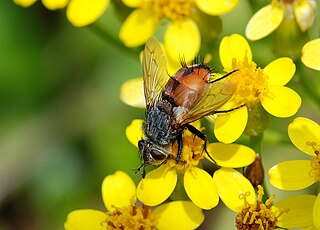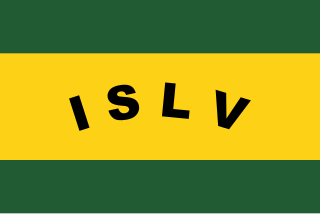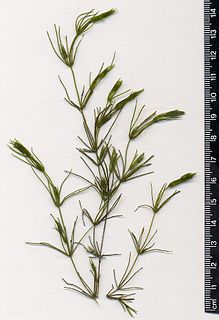
Tahiti is the largest island of the Windward group of the Society Islands in French Polynesia, located in the central part of the Pacific Ocean. Divided into two parts, Tahiti Nui and Tahiti Iti, the island was formed from volcanic activity; it is high and mountainous with surrounding coral reefs. Its population is 189,517 inhabitants, making it the most populous island of French Polynesia and accounting for 68.7% of its total population.

The zucchini, courgette or baby marrow is a summer squash, a herbaceous vine whose fruit are harvested when their immature seeds and epicarp (rind) are still soft and edible. It is closely related, but not identical, to the marrow; its fruit may be called marrow when mature.

The Integrated Taxonomic Information System (ITIS) is an American partnership of federal agencies designed to provide consistent and reliable information on the taxonomy of biological species. ITIS was originally formed in 1996 as an interagency group within the US federal government, involving several US federal agencies, and has now become an international body, with Canadian and Mexican government agencies participating. The database draws from a large community of taxonomic experts. Primary content staff are housed at the Smithsonian National Museum of Natural History and IT services are provided by a US Geological Survey facility in Denver. The primary focus of ITIS is North American species, but many biological groups exist worldwide and ITIS collaborates with other agencies to increase its global coverage.

The Brachycera are a suborder of the order Diptera. It is a major suborder consisting of around 120 families. Their most distinguishing characteristic is reduced antenna segmentation.

Huahine is an island located among the Society Islands, in French Polynesia, an overseas territory of France in the Pacific Ocean. It is part of the Leeward Islands group (Îles sous le Vent). At the 2017 census it had a population of 6,075.

The asparagus bean is a legume cultivated for its edible green pods containing immature seeds, like the green bean. It is also known as the yardlong bean, long-podded cowpea, Chinese long bean, bodi/bora, snake bean, or pea bean. Despite the common name of "yardlong", the pods are actually only about half a yard long, so the subspecies name sesquipedalis is a more accurate approximation.

Rapa, sometimes called Rapa Iti, or "Little Rapa," to distinguish it from Rapa Nui, or Big Rapa, is the largest and only inhabited island of the Bass Islands in French Polynesia. An older name for the island is Oparo. The total land area including offshore islets is 40.5 km2 (15.6 sq mi). As of the 2017 census, Rapa had a population of 507. The island's highest point is at 650 metres (2,130 ft) elevation at Mont Perahu. Its main town is Ahuréi. The inhabitants of Rapa Iti speak their own Polynesian language called the Rapa language.

The bristle-thighed curlew is a medium-sized shorebird that breeds in Alaska and winters on tropical Pacific islands. It has a long, decurved bill and bristled feathers at the base of the legs. Its length is about 40–44 cm and wingspan about 84 cm. The size and shape are the same as the whimbrel's, and the plumage is similar, spotted brown on their upper body with a light belly and rust-colored or buffy tail. The bigger buff spots on the upper body, unmarked light belly and barely marked flanks, tail color, and pale buffy-orange rump distinguish it from the whimbrel.

The Leeward Islands are the western part of the Society Islands in French Polynesia, an overseas collectivity of France in the South Pacific. They lie south of the Line Islands, east of the Cooks and north of the Austral Islands. Their area is 395 km2 and their population is over 33,000.
Cook Islands Māori is an Eastern Polynesian language that is the official language of the Cook Islands. Cook Islands Māori is closely related to New Zealand Māori, but is a distinct language in its own right. Cook Islands Māori is simply called Māori when there is no need to disambiguate it from New Zealand Māori, but it is also known as Māori Kūki 'Āirani, or, controversially, Rarotongan. Many Cook Islanders also call it Te reo Ipukarea, literally "the language of the Ancestral Homeland".

Tame Wairere Iti is a Tūhoe Māori activist in New Zealand. He grew up in the Urewera area, and in the late 1960s and 1970s he was involved in protests against the Vietnam War and apartheid in South Africa, and in many Māori protest actions. His ability to court controversy and his full tā moko make him well-recognised.

Mitiaro, the fourth island in the Cook Islands group, is of volcanic origin. Standing in water 14,750 feet (4,500 m) deep it is four miles (6.4 km) across at its widest point.

Industrial Training Institutes (ITI) and Industrial Training Centers (ITC) are post-secondary schools in India constituted under Directorate General of Training (DGT), Ministry of Skill Development and Entrepreneurship, Union Government to provide training in various trades.

Te Aitanga-a-Hauiti is a Māori iwi (tribe) on the East Coast of New Zealand's North Island. Its rohe covers the area from Tawhiti-a-Paoa Tokomaru Bay to Te Toka-a-Taiau Gisborne on the East Coast of the North Island of New Zealand.

The Engan, or more precisely Enga – Southern Highland languages are a small family of Papuan languages of the highlands of Papua New Guinea. The two branches of the family are rather distantly related, but were connected by Franklin and Voorhoeve (1973).

Chara is a genus of charophyte green algae in the family Characeae. They are multicellular and superficially resemble land plants because of stem-like and leaf-like structures. They are found in freshwater, particularly in limestone areas throughout the northern temperate zone, where they grow submerged, attached to the muddy bottom. They prefer less oxygenated and hard water and are not found in waters where mosquito larvae are present. They are covered with calcium carbonate deposits and are commonly known as stoneworts. Cyanobacteria have been found growing as epiphytes on the surfaces of Chara, where they may be involved in fixing nitrogen, which is important to plant nutrition.

Indian Telephone Industries Limited, commonly known as ITI Limited, is an Indian government-owned telecommunications equipment manufacturing enterprise in India owned by the Department of Telecommunications, a department of Ministry of Communications of the Government of India. It was founded in 1948, and today has six manufacturing facilities which produce a range of switching, transmission, access and subscriber premises equipment. It is headquartered at Bengaluru. It has multi-locational electronic assembly and mechanical manufacturing facilities accredited with ISO 9001:2015, countrywide marketing and customer support centers and in-house R&D for absorption of technology, indigenous development of products for in-house manufacturing.

Psammobates is a genus of tortoise erected by Leopold Fitzinger in 1835. This genus contains three species, all of which are indigenous to southern Africa.
Korafe is a Papuan language spoken in Oro Province, in the "tail" of Papua New Guinea. It is part of the Binanderean family of the Trans–New Guinea phylum of languages. Korafe or could also be called Kailikaili, Kaire, Korafe, Korafi, Korape, and Kwarafe is a language spoken in the Oro Province more specifically in the Tufi District, and Cape Nelson Headlands.

Ilocano is an Austronesian language spoken in the Philippines. It is the third most-spoken native language in the country.

















